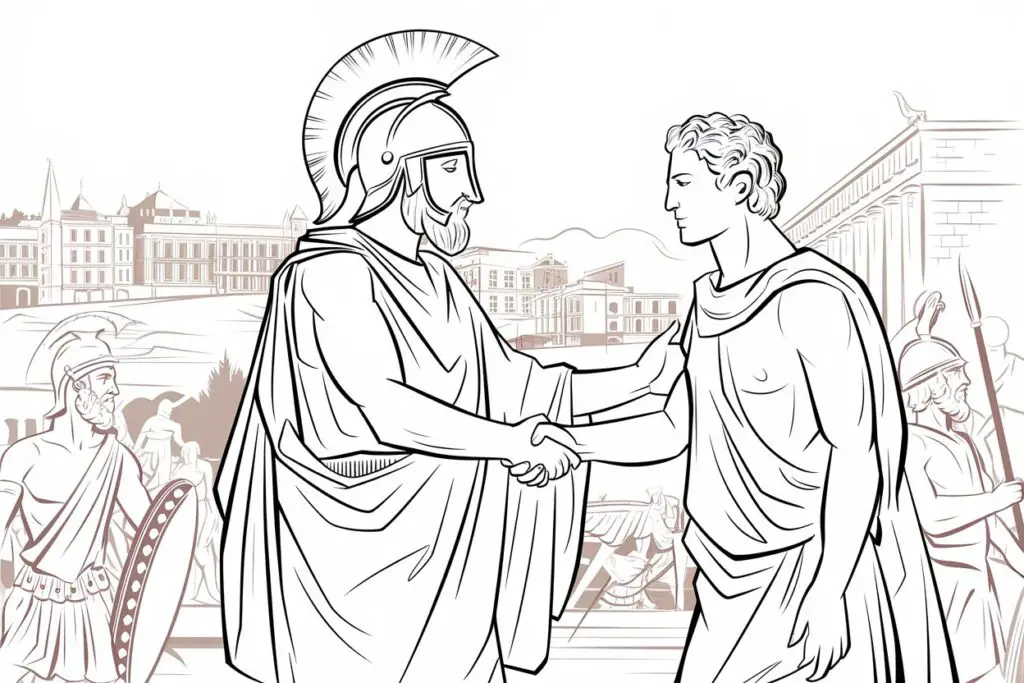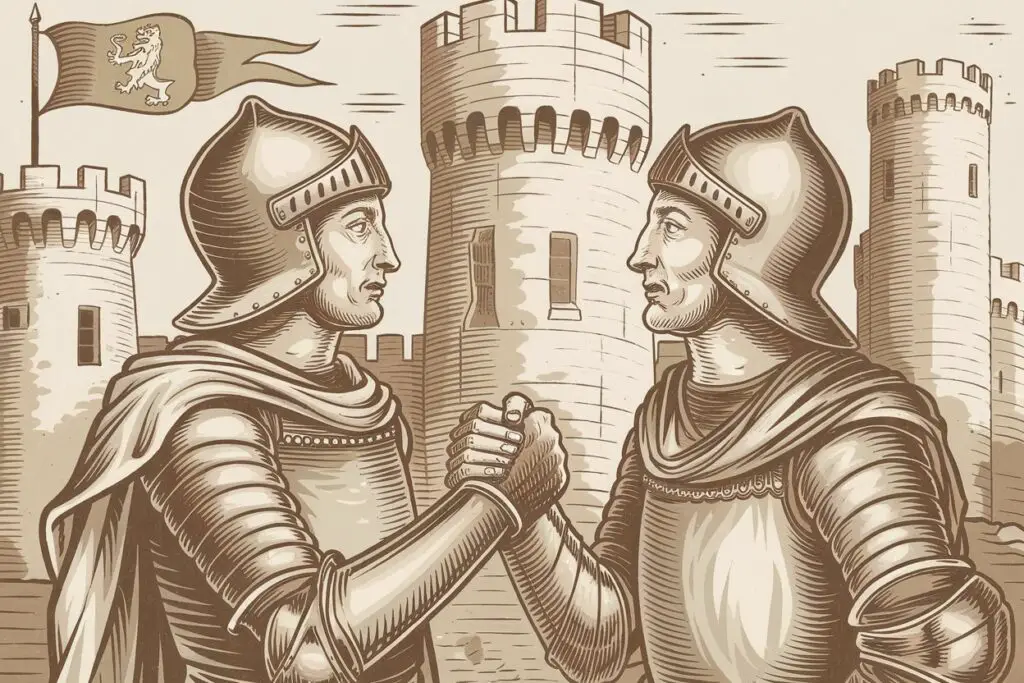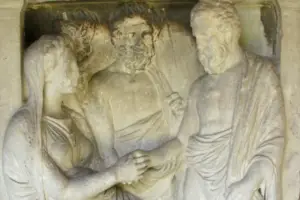Ancient Greece—A Gesture to Show You Weren’t Armed
In ancient Greece, the handshake was more than just a polite greeting—it was a symbolic act of trust and diplomacy. Dating back to at least the 5th century BCE, this gesture was widely depicted in Greek art, from funerary reliefs to painted vases, often illustrating handshakes between gods, warriors, and statesmen. The Greeks referred to this act as “dexiosis”, meaning the offering of the right hand as a sign of goodwill.

But why was this simple motion so important? In a time when city-states were frequently at war, extending an open hand demonstrated that neither party was concealing a weapon—a crucial reassurance in tense encounters. This was especially significant in diplomatic meetings, where a handshake could symbolize an alliance, a truce, or a mutual agreement. Even in Greek mythology and Homeric epics, handshakes appear as gestures of oaths and pledges, reinforcing their deep-rooted cultural meaning.
Interestingly, this early form of handshaking laid the foundation for its later adaptations in the Roman Empire and medieval Europe, where it evolved from a mere greeting into a strategic tool for detecting hidden weapons. While today’s handshake is often seen as a business courtesy, its origins in ancient Greece remind us that it was once a matter of survival and diplomacy.
The Roman Handshake—A Sign of Brotherhood and Trust
In ancient Rome, the handshake was far more than a polite greeting—it was a powerful symbol of trust, unity, and loyalty. Known as dextrarum iunctio, or “joining of right hands,” this gesture carried deep social and political significance. Unlike the simple clasping of hands seen today, the Roman handshake often involved grasping the forearm, a motion that not only demonstrated mutual respect but also reassured both parties that no weapons were concealed. This practice was particularly common in military and diplomatic settings, where alliances were forged, and oaths were sworn with a firm grip.
Beyond military and political contexts, the dextrarum iunctio was a recurring motif in Roman art and coinage, symbolizing harmony and agreement. It frequently appeared on wedding rings, known as Fede rings, which depicted two hands clasped together as a sign of fidelity and commitment between spouses. The handshake even had religious connotations, representing Concordia, the Roman goddess of harmony, underscoring its role in fostering unity among citizens. Whether sealing a business deal, affirming a friendship, or officiating a marriage, the Roman handshake was an enduring emblem of trust and brotherhood—one that laid the foundation for the handshake as we know it today.
Medieval Knights—Shaking Hands to Dislodge Hidden Weapons
In medieval Europe, the handshake took on a more tactical role, particularly among knights and warriors. Unlike today’s polite greeting, this gesture served as a practical security measure. Knights would clasp each other’s hands and shake firmly—not merely as a sign of goodwill, but to ensure that no hidden daggers or small weapons were concealed within sleeves or gauntlets. The physical motion of shaking hands was designed to dislodge any such weapons, reinforcing mutual trust and reducing the risk of surprise attacks.

This practice was especially relevant during an era when personal combat and political betrayals were common. Feudal disputes, shifting alliances, and the ever-present possibility of assassination meant that even a simple meeting could carry significant danger. By engaging in a handshake, knights demonstrated a willingness to engage in open, honorable dialogue rather than resorting to deceitful tactics. It became both a symbolic and functional act—a way to show peaceful intent while also safeguarding oneself.
Over time, this medieval tradition contributed to the handshake’s evolution as a universal symbol of trust. While modern handshakes no longer serve as a literal weapon check, the underlying message of transparency and good faith remains deeply embedded in the gesture.
The Quakers’ Influence—Promoting Equality Through a Simple Greeting
In 17th-century England, the Quakers, formally known as the Society of Friends, introduced a quiet yet radical shift in social etiquette—replacing bows and curtsies with a simple handshake. This was no small gesture. At a time when social hierarchy dictated elaborate displays of deference, the Quakers’ choice to greet everyone with the same egalitarian handshake was a bold statement of their core belief: that all people, regardless of class or status, were equal in the eyes of God.
Unlike the aristocracy, who measured respect through rigid customs, Quakers rejected hierarchical pleasantries altogether. By extending a handshake to both nobles and laborers alike, they dismantled the invisible barriers of social rank with every greeting. This practice wasn’t just symbolic—it became a defining feature of Quaker identity, reinforcing their broader commitment to fairness, honesty, and integrity in daily life. Over time, as Quakers gained influence in commerce and trade, their handshake spread beyond religious circles, subtly shaping broader Western customs.
What began as a quiet act of defiance gradually influenced mainstream etiquette. As business and diplomacy evolved, the handshake became a widely accepted gesture of trust and mutual respect. The Quakers’ legacy lives on in every handshake exchanged today, a reminder that a simple greeting can carry profound meaning.
How Handshakes Became a Global Symbol of Peace and Respect
The handshake’s journey from a practical gesture to a universal symbol of peace and respect is a testament to how human customs evolve over time. Originally, it was a simple way to demonstrate that neither party was carrying a weapon—a sign of goodwill rather than hostility. Ancient Greeks in the 5th century BCE used it as a greeting to show peaceful intent, while Romans took it a step further by grasping forearms to ensure no hidden daggers were present. Over centuries, this act transcended its original function, becoming a recognized gesture of trust and equality across various cultures.
By the 17th century, the Quakers in England played a crucial role in shaping the handshake’s modern meaning. They rejected hierarchical gestures like bowing or tipping hats, favoring a simple handshake as a sign of mutual respect and equality. As global trade and diplomacy expanded, so did the handshake’s influence. By the 19th and 20th centuries, it had become a standard greeting in business and international relations, symbolizing agreements, negotiations, and peaceful cooperation.
Today, the handshake is deeply embedded in global customs, though its execution varies. In the United States and Western Europe, a firm grip is preferred, while in China, a softer handshake is considered more respectful. Despite the rise of alternative greetings—such as fist bumps and bows—especially during health crises like COVID-19, the handshake remains a powerful emblem of unity and respect worldwide.
Cultural Variations—Why Not All Societies Embraced Handshaking
While the handshake has become a near-universal gesture of greeting and agreement, not all cultures have historically embraced it. In many regions, alternative forms of greeting developed based on social norms, religious beliefs, and historical traditions. For example, in Japan, bowing remains the preferred greeting, with the depth of the bow reflecting the level of respect. This tradition stems from centuries of hierarchical social structures, where physical contact was minimized to maintain decorum. Similarly, in China, greetings often involve nods or slight bows rather than handshakes, which are seen as a Western import.
In parts of the Middle East, handshakes are common among men, but direct hand contact between unrelated men and women is often discouraged due to religious customs. Instead, a slight nod or placing a hand over the heart may serve as a respectful greeting. Meanwhile, in Tibet, an unusual yet historically significant greeting involves sticking out the tongue—a practice that dates back to the 9th century to demonstrate that one is not the reincarnation of a cruel king. In the Democratic Republic of Congo, close male friends may touch foreheads, while in New Zealand, the Māori hongi—a gentle pressing of noses—symbolizes the exchange of breath and life force.
Even in Western societies, the handshake has faced challenges. The COVID-19 pandemic led to a surge in alternative greetings like fist bumps and elbow taps, highlighting how cultural norms can shift in response to global events. Despite its widespread use, the handshake is far from universal, and understanding these variations is key to respectful cross-cultural interactions.
The Evolution of the Handshake in Modern Diplomacy and Business
The handshake has long been a symbol of trust and respect, but in modern diplomacy and business, its significance has evolved alongside globalization and technological advancements. In international relations, a handshake is more than a simple greeting—it is a carefully choreographed gesture that can signal cooperation, negotiation breakthroughs, or even political tensions. High-profile diplomatic handshakes, such as the 1986 meeting between Ronald Reagan and Mikhail Gorbachev or the 2018 handshake between Donald Trump and Kim Jong-un, have been scrutinized for their deeper political implications. These moments illustrate how physical gestures can reinforce or challenge diplomatic narratives in an increasingly interconnected world.
In the business sphere, handshakes remain a fundamental part of professional etiquette, particularly in Western cultures. A firm handshake is often perceived as a sign of confidence and reliability, influencing first impressions in job interviews, negotiations, and corporate meetings. However, cultural variations persist—while a strong grip is valued in the United States and Germany, a lighter handshake is preferred in Japan and certain Middle Eastern countries. The COVID-19 pandemic further reshaped business interactions, accelerating the acceptance of alternative greetings like fist bumps and elbow taps. As hygiene awareness grows, some experts speculate whether traditional handshakes will decline in favor of more contact-free gestures. Yet, despite these changes, the handshake continues to symbolize trust and agreement, adapting to the nuances of modern professional and diplomatic engagements.







